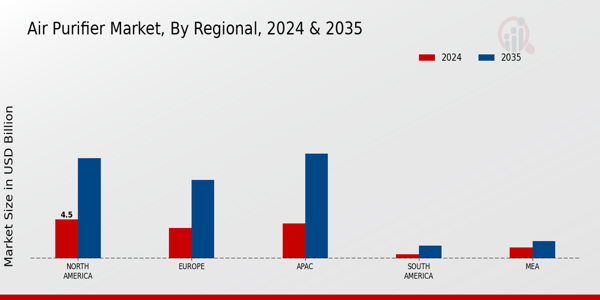Market Growth Projections
The Global Air Purifier Market Industry is poised for substantial growth, with projections indicating a market value of 13.8 USD Billion in 2024 and a remarkable increase to 35 USD Billion by 2035. This growth trajectory suggests a compound annual growth rate of 8.86% from 2025 to 2035, reflecting the increasing demand for air purification solutions. Factors such as rising pollution levels, technological advancements, and heightened consumer awareness contribute to this positive outlook. As the industry evolves, it is likely to witness innovations that enhance product efficiency and sustainability, further driving market expansion.
Increasing Air Quality Awareness
The Global Air Purifier Market Industry experiences a notable surge in demand as public awareness regarding air quality escalates. Individuals are increasingly cognizant of the adverse health effects associated with poor air quality, including respiratory diseases and allergies. This heightened awareness is reflected in the projected market value of 13.8 USD Billion in 2024, indicating a robust consumer shift towards air purification solutions. Governments and health organizations are actively promoting clean air initiatives, further driving consumer interest in air purifiers. As a result, the industry is likely to witness sustained growth, with consumers prioritizing health and well-being in their purchasing decisions.
Regulatory Support and Standards
Regulatory frameworks and standards established by governments worldwide contribute significantly to the Global Air Purifier Market Industry. Policies aimed at improving air quality and reducing pollution levels encourage the adoption of air purification technologies. Governments are increasingly mandating stricter emission standards for industries and promoting the use of air purifiers in residential and commercial settings. This regulatory support not only fosters consumer confidence but also incentivizes manufacturers to innovate and comply with environmental standards. As a result, the market is likely to experience growth driven by both consumer demand and regulatory compliance, ensuring a healthier environment for communities.
Urbanization and Population Growth
Urbanization continues to be a driving force behind the Global Air Purifier Market Industry. As more individuals migrate to urban areas, the demand for air purification solutions intensifies due to increased pollution levels. Rapid urban development often correlates with higher emissions from vehicles and industrial activities, leading to deteriorating air quality. Consequently, the market is expected to grow significantly, with projections indicating a value of 35 USD Billion by 2035. This urban-centric demand for air purifiers underscores the necessity for effective air quality management solutions, positioning the industry for sustained expansion in response to urban challenges.
Diverse Applications Across Sectors
The versatility of air purifiers across various sectors enhances the Global Air Purifier Market Industry. Air purifiers are utilized in residential, commercial, and industrial applications, catering to a wide range of consumer needs. In residential settings, they provide relief from allergens and pollutants, while in commercial spaces, they contribute to employee health and productivity. The industrial sector also benefits from air purification solutions to comply with environmental regulations. This diverse applicability broadens the market's reach, allowing it to adapt to different consumer demands. As awareness of air quality issues grows, the industry is likely to expand further, driven by the need for effective air purification solutions.
Technological Advancements in Filtration
Technological innovations play a pivotal role in shaping the Global Air Purifier Market Industry. The introduction of advanced filtration technologies, such as HEPA filters and activated carbon systems, enhances the efficiency of air purifiers in removing pollutants and allergens. These advancements not only improve product performance but also attract environmentally conscious consumers seeking sustainable solutions. As manufacturers invest in research and development, the market is poised for growth, with a projected compound annual growth rate of 8.86% from 2025 to 2035. This trend suggests that consumers are increasingly inclined to adopt air purifiers equipped with cutting-edge technology, thereby expanding the market further.

























Leave a Comment